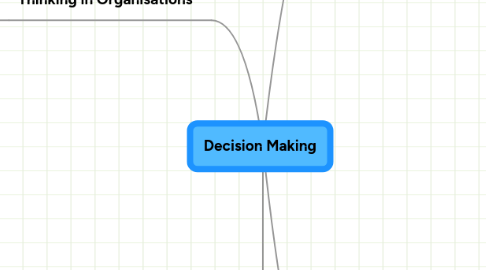
1. Thinking in Organisations
1.1. Smircich & Stubbart
1.1.1. Three models for knowing environment
1.1.1.1. An objective environment
1.1.1.2. The perceived environment
1.1.1.3. The enacted environment
1.1.2. Organisation and environment from interpretive perspective
1.1.2.1. Implications of interpretive perspective
1.1.2.1.1. Abandoning organisations should adapt to environments
1.1.2.1.2. Rethinking constraints, threats, opportunities
1.1.2.1.3. Thinking differently about role of strategic managers
1.1.2.2. Managing in an enacted world
1.1.2.2.1. Managerial analysis
1.1.2.2.2. Creation of context
1.1.2.2.3. Encouraging multiple realities
1.1.2.2.4. Testing and experimenting
1.1.2.2.5. Can reality be enacted?
1.1.3. Conclusion
1.1.3.1. Eclipse of organisation/environment dichotomy
1.1.3.2. Different mode of strategic analysis
1.1.3.3. Different role for strategist
1.1.3.4. Different research focus
1.2. Lant et al
1.2.1. Patterns of strategic reorientation
1.2.2. Influence of magerial learning on strategic persistance/reorientation
1.2.3. Research model
1.2.3.1. Effect of environmental context on rates or reorganisation
1.2.3.2. Managerial learning process and likelihood of reorganisation
1.2.3.2.1. Role of past performance
1.2.3.2.2. Role of managerial interpretations
1.2.3.2.3. Role of top management characteristics
1.2.3.3. Effects of past performance on top management and managerial interpretation
1.2.4. Empirical study
1.2.5. Discussion
1.2.5.1. Determinants of strategic reorganisation
1.2.5.1.1. Past performance
1.2.5.1.2. Managerial interpretations
1.2.5.1.3. Top management characteristics
1.2.5.2. Speculating about processes
1.2.5.2.1. Past performance on managerial interpretations
1.2.5.2.2. Past performance on top management characteristics
1.3. Schwenk
1.3.1. Research on strategic cognition
1.3.1.1. Cognitive heuristics and biases
1.3.1.2. Strategic assumptions, cognitive maps and schemata
1.3.1.3. Analogy in diagnosis
1.3.2. Integration and questions for research
1.3.2.1. Development of schemata
1.3.2.2. Application of schemata
1.4. Bate
1.4.1. What is organisational culture
1.4.2. Methodology
1.4.3. Findings
1.4.3.1. Unemotionality
1.4.3.2. Depersonalisation
1.4.3.3. Subordination
1.4.3.4. Conservatism
1.4.3.5. Isolationism
1.4.3.6. Antipathy
2. Understanding Decision Making: Understanding Organisations
2.1. Pettigrew
2.1.1. Power and organisational decision making
2.1.2. Theoretical bearings
2.2. Brunsson
2.2.1. Decision making perspective and irrationality
2.2.2. Decisions as initiators of action
2.2.2.1. Searching for alternatives
2.2.2.2. Estimating consequences
2.2.2.3. Evaluating alternatives
2.2.2.4. Choosing
2.2.2.5. Making rational use of irrationality
2.3. Strauss et al
2.3.1. Professionalised locale
2.3.2. Ruled and unruled behaviour
2.3.3. Grounds for negotiation
2.3.4. Patients and negotiated order
2.3.5. Patterned and temporal features of negotiation
2.3.6. Negotiation, appraisal and organisational change
2.4. Zimmerman
2.4.1. Reception Function
2.4.1.1. Actual task structure in reception
2.4.1.2. Troubles and consequences
2.4.2. Actual task structure and competent rule use
2.4.2.1. Intake assignment procedure
3. Anatomy of Decision Making
3.1. Janis
3.1.1. Groupthink
3.1.1.1. Illusion of invulnerability
3.1.1.2. Illusion of unanimity
3.1.1.3. Suppression of personal doubts
3.1.1.4. Self-appointed mindguards
3.1.1.5. Docility fostered by suave leadership
3.1.1.6. Taboo against antagonising new members
3.2. Valentin
3.2.1. Behavioural perspective
3.2.1.1. Group dynamics & organisational culture
3.2.1.2. Structure of managerial decision making
3.2.1.3. Behavioural framework for studying organisations
3.2.2. Strategic context
3.2.3. Behavioural processes in context
3.3. Cyert & March
3.3.1. Goals, expectations and choice
3.3.1.1. Organisational goals
3.3.1.2. Organisational expectations
3.3.1.3. Organisational choice
3.3.2. Four main relational concepts
3.3.2.1. Quasi resolution of conflict
3.3.2.1.1. Goals as independent constraints
3.3.2.1.2. Local rationality
3.3.2.1.3. Acceptable-level decision rules
3.3.2.1.4. Sequential attention to goals
3.3.2.2. Uncertainty avoidance
3.3.2.2.1. Feedback-react decision procedures
3.3.2.2.2. Negotiated environment
3.3.2.3. Problemistic search
3.3.2.3.1. Motivated search
3.3.2.3.2. Simple-minded search
3.3.2.3.3. Bias in search
3.3.2.4. Organisational learning
3.3.2.4.1. Adaptation of goals
3.3.2.4.2. Adaptation in attention rule
3.3.2.4.3. Adaptation in search rules
3.4. Miller et al
3.4.1. Why decision making
3.4.2. Managerial rationality in decision making
3.4.3. Decision making as enactment of power
3.4.4. Processes, prescriptions and explanations
3.4.4.1. Bradford studies: explanations for process
3.4.4.2. Strategies and garbage cans: chaos and disorganised order
3.4.4.3. Mapping terrain of decision making process
3.4.4.3.1. Action dimension
3.4.4.3.2. Interest dimension
3.4.5. Concept of a decison
4. Societal Context of Organisational Decision Making
4.1. Brunsson & Olsen
4.1.1. Administrative reform and change
4.1.1.1. How free is the choice
4.1.2. Institutionalised organisations
4.1.3. Institutionalised environments
4.1.3.1. Decoupling
4.1.3.2. Modernity and fashion
4.1.3.3. Creation of meaning
4.1.4. Challenging a hegemony
4.2. du Gay & Salaman
4.2.1. Close to the customer
4.2.2. Enterprising culture of customer
4.2.3. Enterprising enterprises
4.2.4. Discourse of enterprise
4.3. Newman
4.3.1. Bashing bureaucracy
4.3.2. Managerialism as discourse
4.3.2.1. Neo-Taylorism
4.3.2.2. Excellence approach
4.3.2.3. Consumerism and quality
4.3.2.4. Business entrepreneurship
4.3.3. Power, decision making and reordering relationships
4.3.3.1. Managerialism as logic of decision making
4.3.3.2. Multiple and interacting regimes
4.3.3.3. Reordering relationships
4.3.3.3.1. Management/workforce relations
4.3.3.3.2. Organisational and inter-organisational relationships
4.3.3.4. Paradoxes of managerialism
4.3.3.4.1. Centralisation and decentralisation
4.3.3.4.2. Flexibility and standardisation
4.3.3.4.3. Empowerment and control
4.3.3.4.4. Management, policy and politics
4.4. Laroche
4.4.1. Limits of decision making perspective
4.4.1.1. Lost object of decision making
4.4.1.2. Managers as decison makers
4.4.1.3. Away from rationality and back
4.4.2. From decision to action
4.4.2.1. Action first, decision later
4.4.2.2. Towards a theory of action in organisations
4.4.3. Decision making as a social representation
4.4.3.1. Recoupling and decision and action
4.4.3.2. Social representation of decision making
4.4.3.3. Which representation of decision making
4.4.4. Decision making in action
4.4.4.1. Self fulfilling prophecies
4.4.4.2. Looking forward: decisions as useful illustrations
4.4.4.3. Looking back: decisions as rationalisations
